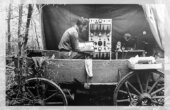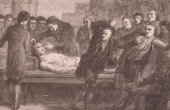Powers of Hearing: The Military Science of Sound Location
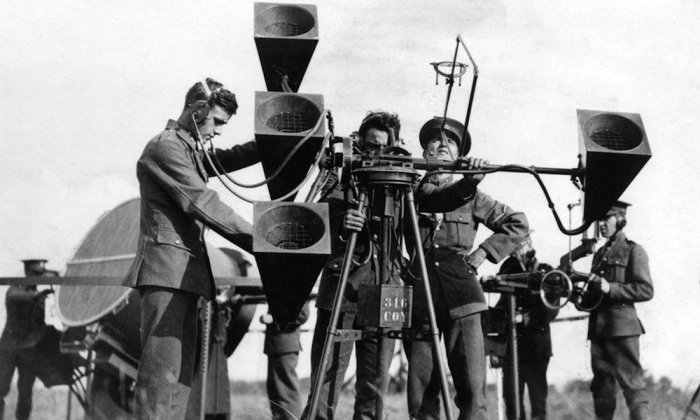
According to “The End of the War: A Graphic Record,” the frontispiece of a towering report commissioned by the U.S. Assistant Secretary of War during WWI, the Great War ended not with a bang, but, as in the famous verse, a whimper.
The image, which showed six horizontal lines on a filmstrip, depicted artillery activity at the American front near the Moselle River exactly one minute before and one minute after the time of armistice, 11:00 a.m. on November 11, 1918. The left side depicted artillery activity at one minute before armistice and showed a flurry of jagged lines (“All guns firing”). On the right side, which depicted artillery activity at one minute after armistice, there were only smooth lines (“All guns silent”). Two small dips around 11:01:01 were attributed to the exuberance of a doughboy who fired his pistol twice in celebration of the ceasefire. Apart from these gunshots, it appeared that artillery activity had ceased entirely, and that the battlefield had been suddenly drained of the throttling sounds of gunfire.

The caption for “The End of the War” stated that it was the last record of artillery activity at the American front, and that the image issued from an American sound ranging apparatus. “Sound ranging,” it read, “was an important means of locating the positions and calibers of enemy guns.” When the image was reproduced in the Journal of Electricity the claims made about it were even grander: “Truly history has here been written electrically!”
“The End of the War” was produced through one of numerous methods of acoustic defense that were invented during the First World War. At the outset of the war the concept of acoustic defense was mostly unknown. None of the principal armies possessed reliable means for tracking the position of the enemy by following the sounds it made. By the end of the war, however, each had developed new technologies and techniques for sound location, typically in response to new technologies of offense, and each had employed these methods on countless occasions — thereby generating new modes of “acoustic defense.”
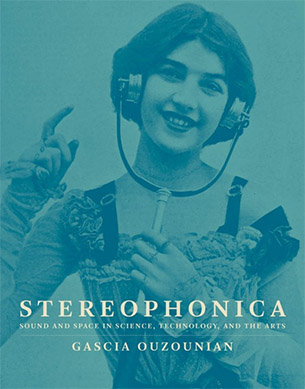
The appearance of a new offensive weapon, however, did not mean that new methods of defense were easily come by. According to Alfred Rawlinson, Lieutenant Commander of the Royal Naval Volunteer Reserve, the enemy was prone to hiding behind clouds. How should the guns of the defense hit an object they could not see? The answer, he said, was “childishly simple — namely, though we can’t see it, yet we can hear it. Therefore, as we cannot aim by using our eyes, we shall be obliged to shoot, if we are to shoot at all, by using our ears to aim with.” Still, he wrote, there was “a terribly long way to go before theory, however correct, could be turned into practice.”
Until the early 20th century, spatial hearing had been studied almost exclusively in terms of the physics of sound or the physiology and psychology of hearing. During the war it was recast as a tactical activity that was understood in strategic terms — as something that could determine human and even national survival. Auditory space perception, once considered subordinate to visual space perception, was newly understood as a vital skill, with “powers of hearing” suddenly mapped onto the powers of nation states.
Observing Sounds: Acoustic Sights, Listening Discs, and the Baillaud Paraboloid
The first sound locators used in the First World War relied heavily on the idea of “seeing” sound. Some were based on technologies of vision and transposed principles derived from optical science onto the acoustic domain. In 1916 a Lieutenant in the French Army designed a viseur acoustique (“acoustic visor”), a handheld device that comprised a mirror and compass. A soldier used the instrument by centering the reflection of his face in the mirror such that he could see his ears equally well. The compass would then presumably give the direction of the sound.
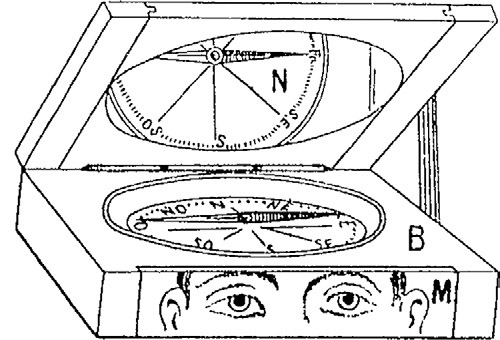
Experiments were undertaken in England with listening discs, a technology that was based on the idea that, when a soundproof disc was oriented towards the source of sound, an acoustic image would form at the center of the disc on the side opposite to that of the sound. The idea was proposed as an acoustic analogue to the Arago spot in optics, whereby a bright point appears at the center of the shadow of a circular object due to the wave nature of light.
While technologies like acoustic visors and listening discs were neither particularly effective nor practicable, one of the most enduring acoustic defense technologies to emerge from the war, the Baillaud paraboloid, was also based on a technology of vision. Although there are examples of acoustic reflectors throughout history, the first parabolic acoustic reflector designed expressly for military use was invented by René Baillaud in 1915, and given the form of a dish or a bowl. Baillaud, an astronomer based at the Toulouse Observatory, modeled his device on the Newtonian telescope. His design was based on the premise that parabolic mirrors must share the same properties of reflection whether they were reflecting light or sound.
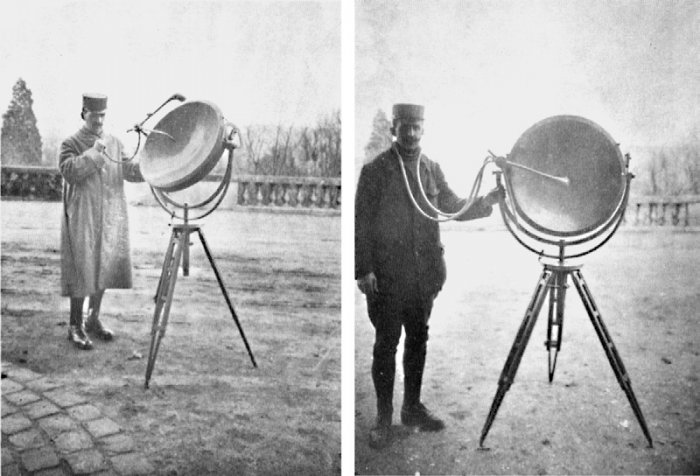
In Baillaud’s memoirs a series of photographs shows the development of the acoustic paraboloid over an intensive, approximately year-long period of experimentation. We find instruments of increasing size, ranging from 60 centimeters to 3 meters in diameter; of varying shapes, whereby the dish appears less like a concave dish and more like a deep bowl; and of varying configurations, including one in which four paraboloids were stacked in rows of two. A single auditor listening using a stethoscope-like device at the point of greatest focus becomes two auditors, who listen in tandem while each one is seated at opposite ends of the device, using hand wheels to rotate the dish. We also find the introduction of an automatic course plotter, an imaging technology that traced the auditors’ movements, thereby producing a visual record of the trajectory of the aircraft.
Alt-Azimuth Listening: The Four-Trumpet Sound Locator
Military aircraft of the First World War produced several kinds of sounds: the beat of the propeller, engine sounds, and vibrations caused by friction between the air and the body of the moving airplane. The loudest and most easily identifiable sound, however, was what was called the “exhaust note.”
The exhaust notes of various aircraft ranged between 80 hertz and 130 hertz, and although this pitch varied somewhat when the aircraft was in motion, it was invariably a low-frequency sound. In order to reflect the low-frequency sounds of aircraft, each of the principal armies developed trumpet sound locators (also called horn sound locators) that replaced the small trumpets of artillery ranging devices with large conical trumpets that could reflect low frequency sounds. According to A. V. Hill, professor of physiology at the University of Cambridge and director of the Anti-Aircraft Experimental Section in England in the early 20th century, the first type of trumpet sound locator developed by the British Army had only a single pair of large horns, which measured approximately 40 inches in diameter at the mouth. This device, which was first used as part of the Anti-Aircraft Defense of London in 1917, could determine only the horizontal bearing of enemy aircraft. A second model, which was developed almost immediately, had two pairs of horns, and was sometimes called the “four-trumpet” or “four-horn” sound locator. One pair of horns was used to determine the elevation of the aircraft (its altitude), while the other pair was used to determine its horizontal bearing (azimuth).
One pair of horns was used to determine the elevation of the aircraft (its altitude), while the other pair was used to determine its horizontal bearing (azimuth).
The “alt-azimuth” mounting of the horns necessitated two auditors, who engaged in what might be thought of as a “double binaural” mode of listening. Each auditor listened via a stethoscope-like binaural earpiece that was connected only to one set of horns. One auditor listened only to the aircraft’s elevation, while another listened to its horizontal bearing. It was therefore the auditors’ combined auditory impressions that were used to track the aircraft, which was ascertained by equalizing the sound level at the two ears, a process that was called “bracketing the sound.”
Four-trumpet sound locators were heavy, labor-intensive devices that required considerable effort to transport and use. Moreover, listening through trumpet sound locators was almost always done in adverse conditions that could not be replicated in any laboratory. Military auditors almost always operated in the dark, already a difficult task, and they often listened in poor weather and in the chaotic and terrifying conditions of battle. Soldiers were known to have suffered instantaneous deafness in battle; and soldiers recalled “seeing gunners’ ears bleeding.”
Hearing damage and listener fatigue were commonplace when listening through sound locators. Not only was the listener engaged in a difficult and taxing activity in unfamiliar and unpredictable settings, but he was almost certainly at risk of death. In this context, “heightened listening” was an extreme proposition.
Ear Training for Sound Observers: The Acoustic Goniometer
Given the precarious nature of listening in such extreme conditions, military auditors received extensive training to develop their directional listening skills. A military manual on the acoustic goniometer, a French device, contains passages on the “Training of Sound Observers” and “Ear Training for Listeners.” These passages describe in detail the various ear-training exercises a military auditor was required to undertake to qualify for operating the acoustic goniometer, an alt-azimuth sound locator in which two sets of ten small, clustered horns replaced the large conical horns of the four-trumpet sound locator.
Listening exercises with the acoustic goniometer were conducted in five stages. In the first stage an auditor listened to a fixed sound source approximately 100 meters away. An assistant provided the sound either by counting, clapping his hands, or sounding a trumpet. The assistant then moved sideways to another point while the auditor reoriented the instrument towards him. This first exercise served to eliminate unreliable listeners. If an auditor’s “acoustic aimings” deviated too much, the auditor would not be permitted to pass to the second stage.
If an auditor did not practice every day, it was believed that he “would quickly lose the efficiency acquired.”
During the second stage an assistant mimicked a moving sound source, producing a continuous sound while walking continuously at a rate of approximately one meter per second, at a distance of approximately 150 to 200 meters from the auditor. The auditor attempted to follow the sound by continuously reorienting the goniometer towards the assistant. An instructor who stood between the auditor and the assistant whistled at random. At these points the assistant stopped moving and the auditor’s acoustic aiming was verified.
For the third and fourth stages the auditor followed the sound of an actual airplane, first tracking its horizontal bearing and then its elevation. In the fifth and final stage, two auditors followed an airplane simultaneously, with one listening for its horizontal bearing and the other for its elevation. It was decided that auditors “should be trained every day systematically” and that daily listening practice was “absolutely indispensable.” If an auditor did not practice every day, it was believed that he “would quickly lose the efficiency acquired.”
Sonic Trajectories: The Perrin Telesitemeter
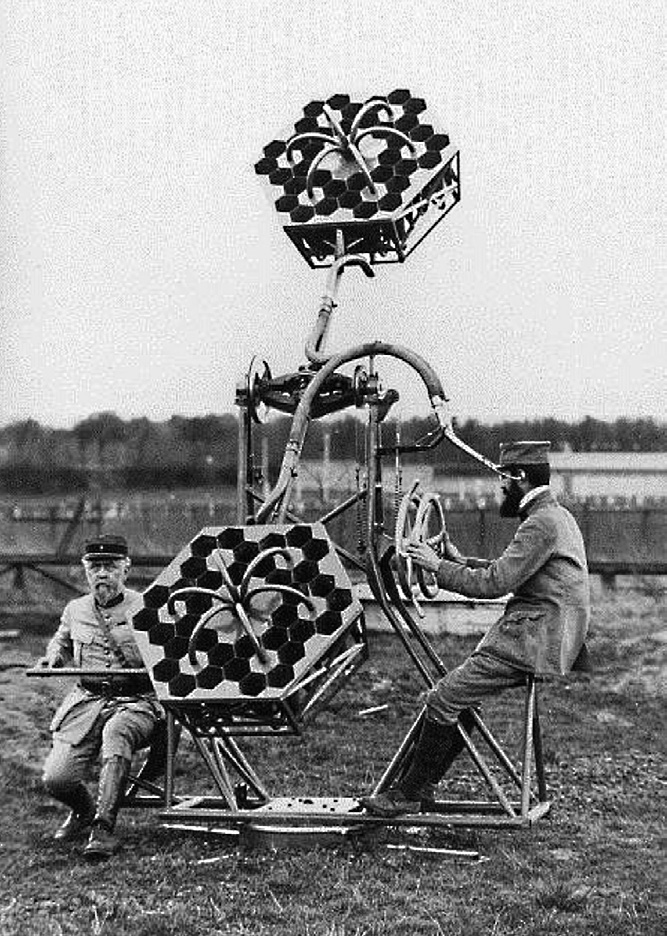
One of the most mechanically complex sound locators of the war was the Perrin telesitemeter (télésitemètre Perrin), named after the French physicist Jean Baptiste Perrin. It was based on the premise that the amount of sound amplification that could be achieved by a conical horn was necessarily limited by the size and length of the horn. In seeking to increase the sound locator’s amplifying power but not its size, Perrin designed a receiver that clustered dozens of elementary horns in hexagonal, honeycomb-like nests. These “primary horns” were connected to a central horn by a suite of tubes, and two auditors each listened binaurally via an additional length of tubing. The idea was that the multicellular horn assemblages, called “myriaphones,” would enable the device to collect a substantial amount of acoustic energy while the instrument itself could remain relatively small and therefore practicable in the context of mobile warfare.
According to A.V. Hill, many people believed that the Perrin telesitemeter gave a “more decided position of centrality” than trumpet sound locators, and that the sensation of passage of sound between the two ears seemed “more pronounced” with the telesitemeter.
New Frontiers in Listening
During the First World War an expert class of military auditor emerged, one whose ability to sense the location and direction of sounds became a key asset in military operations. In France, military auditors were trained on a daily basis, and directional listening was understood as a skill that could be developed through ear training. In the context of acoustic defense, a “good listener” was not necessarily someone who could hear well. Rather, a good listener was one who could use their spatial hearing sense to locate and track the source of a sound.
Over the course of the war acoustic defense technologies became more complex, not only in terms of their increasingly elaborate designs, but also in the kinds of listening they required. Cooperative and collaborative modes of listening emerged that involved several auditors — and teams of others — who worked in tandem to sense and interpret acoustic activity. Especially in the later years of the war, listening in the context of acoustic defense was a distinctly group effort.
Almost every act of defensive listening involved a complex sequence of procedures that required specialist knowledge, cooperation between several auditors and other observers, and communication between teams of people. In this way, listening became a fragmented process that was divided between many people, each of whom was assigned to a different part of the “listening act.” Meanwhile, the listening act itself was reconfigured from a single, continuous, coherent act carried out by individuals in everyday contexts to a set of systematized, discrete actions carried out by groups of auditors under the extreme conditions of warfare.
Since the role of the military auditor was both to listen and to continuously report his findings, listening was further reconfigured as an act of data collection. The military auditor did not typically interpret the meaning of sounds so much as he acted as an acoustic sensor, one whose role was fundamentally to observe and report physical acoustic data. In this sense, military listening was essentially a mechanical task that prefigured contemporary forms of machine listening. Human auditors performed the function that machines perform today, by enacting functional and highly rationalized modes of listening: militarized forms of what sound studies scholar Jonathan Sterne has called “audile technique.”
Through acoustic defense, listening was equally reconfigured as sensing, observing, or visually plotting acoustic energy versus merely “hearing” sound. In some acoustic defense methods, the visual representation of sound, and calculations relating to acoustic activity — determining the influence of atmospheric conditions like wind and temperature on the propagation of sound on a particular day, for example — superseded the sense of hearing. In other words, it was not always how the sound “sounded” that mattered in acoustic defense. Rather, in many cases it was the physical behavior of sound that was the most consequential part of the listening equation.
Technologies of acoustic defense made it possible to experience sound as “a vibratory motion of matter” in a tangible way.
If sound is understood not as something to be heard but rather as something to be sensed — or indeed, observed — then its definition must also change. At the start of the war sound was commonly understood as “the effect produced upon the auditory nerve by certain vibratory motions,” a definition that was cited as standard by Hill. However, this definition was not always applicable in the context of acoustic defense, since it was sometimes necessary to consider sound, as one military leader wrote, “without reference to its ultimate detection by the ear.” Hill therefore suggested that a more appropriate definition of sound would be that of “a vibratory motion of matter of the type to which the organ of hearing responds.” While this certainly corresponded to well-established ideas about sound, technologies of acoustic defense made it possible to experience sound as “a vibratory motion of matter” in a tangible way.
Acoustic defense equally made concrete the idea that “sound travels.” Thousands of people — including military auditors, as well as the many civilians living under the threat of aerial bombardment — oriented themselves not towards the visible source of sound but towards the path of sound. Acoustic defense made sensible the idea that sound moves, and that, by orienting oneself towards its movements, one might reorient history itself.
Gascia Ouzounian is Associate Professor of Music at the University of Oxford and the author of “Stereophonica: Sound and Space in Science, Technology, and the Arts,” from which this article is adapted.
